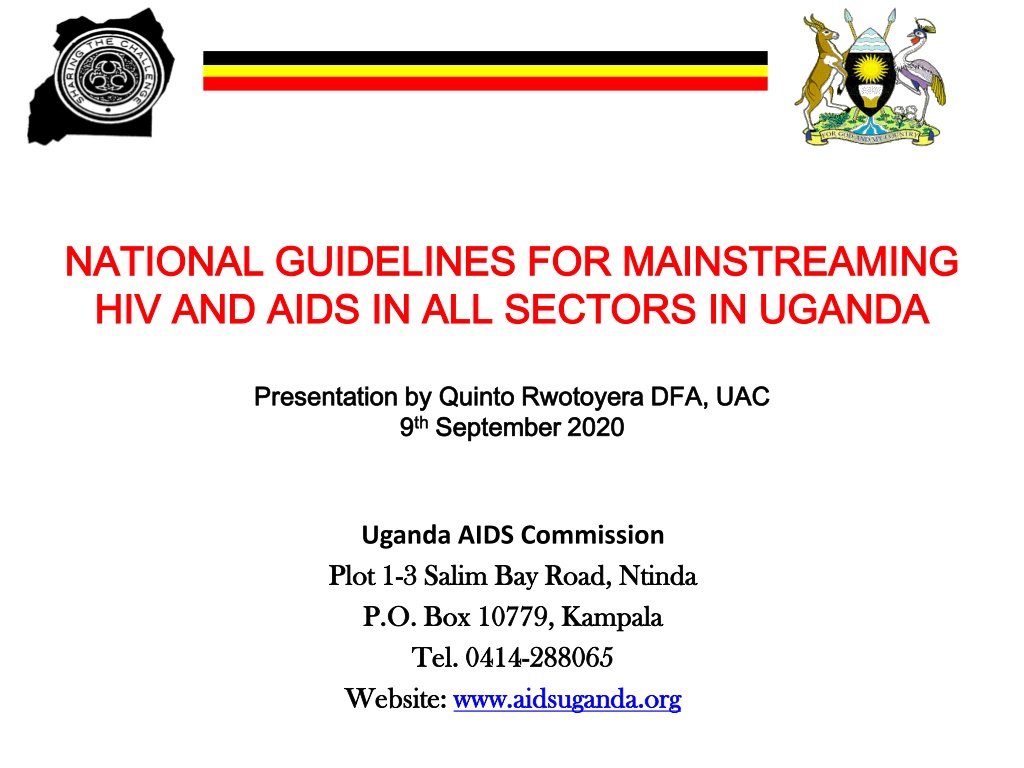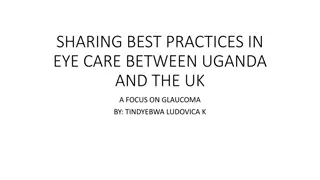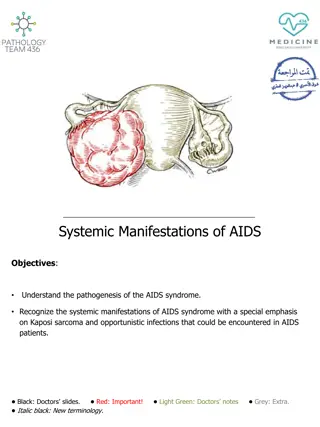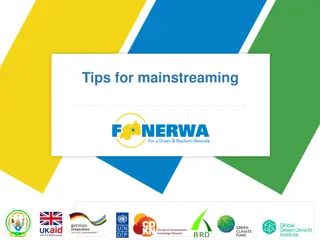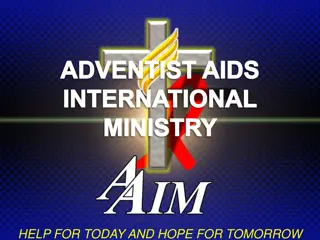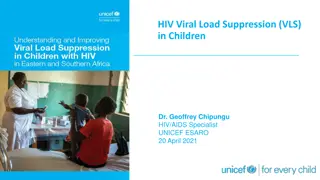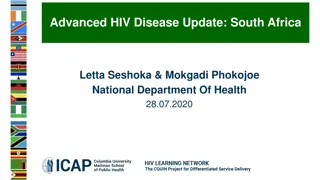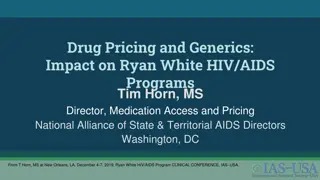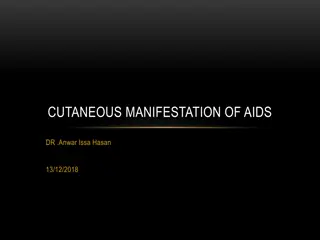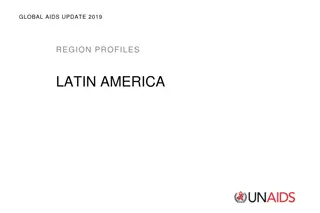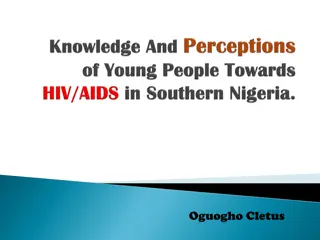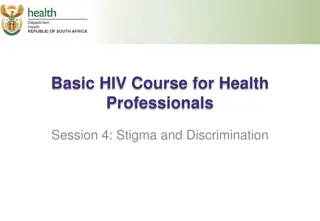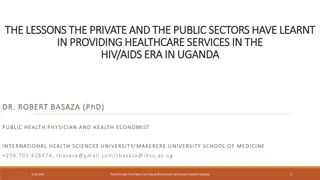Mainstreaming HIV and AIDS in Uganda: Guidelines and Initiatives
The presentation by Quinto Rwotoyera from Uganda AIDS Commission discusses the national guidelines for mainstreaming HIV and AIDS in all sectors in Uganda. The content covers the existing policy and guidelines, overview of the presidential FastTrack initiative, objectives of the guidelines, users of the guidelines, priority areas for mainstreaming, budget allocation, expected results, coordination, and specific guidelines. The aim is to reduce the threat of HIV and AIDS and involve all sectors in addressing the causes and effects of the epidemic for sustainable development in Uganda.
Download Presentation

Please find below an Image/Link to download the presentation.
The content on the website is provided AS IS for your information and personal use only. It may not be sold, licensed, or shared on other websites without obtaining consent from the author. Download presentation by click this link. If you encounter any issues during the download, it is possible that the publisher has removed the file from their server.
E N D
Presentation Transcript
NATIONAL GUIDELINES FOR MAINSTREAMING NATIONAL GUIDELINES FOR MAINSTREAMING HIV AND AIDS IN ALL SECTORS IN UGANDA HIV AND AIDS IN ALL SECTORS IN UGANDA Presentation by Quinto Rwotoyera DFA, UAC Presentation by Quinto Rwotoyera DFA, UAC 9 9th thSeptember 2020 September 2020 Uganda AIDS Commission Plot 1 Plot 1- -3 Salim Bay Road, 3 Salim Bay Road, Ntinda P.O. Box 10779, Kampala P.O. Box 10779, Kampala Tel. 0414 Tel. 0414- -288065 Website: Website: www.aidsuganda.org www.aidsuganda.org Ntinda 288065
Presentation Outline Introduction Existing Policy and Guidelines HIV & AIDS Mainstreaming Overview of Presidential FastTrack Initiative Objectives of the Guidelines Users of the guidelines HIV& AIDS Mainstreaming process Priority areas for HIV & AIDS mainstreaming HIV& AIDS Budget Allocation Expected results of HIV & AIDS mainstreaming Coordination and Management Arrangement Specific guidelines on use of 0.1% Current Sector/MDA allocation for HIV and AIDS
Introduction, Context & Purpose Declining HIV prevalence (7.3% in 2011 & 6% 2017) HIV&AIDS remains a substantial threat to Uganda s socio-economic development. Despite these successes, the burden remains high especially among certain subgroups showing increasing new HIV infections. E.g. Young girls HIV/AIDS remains largely funded by development partners. Involvement of all sectors to address the causes, drivers and effects of HIV is the sustainable approach
Existing Policy and Guidelines HIV&AIDS guidelines 2018 to mainstream HIV and AIDS in all sectoral plans/programs and budgets. MOFPED has consistently instructed sectors/MDA- LG to include HIV AIDS in their planning and budgeting. Mainstreaming Policy 2008 and There are however notable gaps that hinder the full realization of mainstreaming goals. mainstreaming by sectors not to scale & hence the impact of these sector HIV&AIDS interventions not fully realized. Fragmented mainstreaming efforts, & not standardized with adhoc implementation in sectors Allocation and appropriation of resources for HIV&AIDS mainstreaming not standardized.
HIV&AIDS Mainstreaming Definition: A process that enables management of sectors and institutions to address the causes and effects of HIV and AIDS in an effective and sustained manner, both through their usual work and within their workplace (UNAIDS, 2005) Mainstreaming is in two key domains: The Internal (workplace): - to reduce vulnerability of employees The External (linked to the core function of a sector): - taking action to contain the threats posed by the epidemic to the achievement of the sector goals, as well as ensuring that the sector s practices do not exacerbate the epidemic.
Overview of Presidential Fast Track initiative 1. Engage men in HIV Prevention and close the tap on new infections Particularly among adolescent girls and young women 2. Accelerate Implementation and Treat and attainment of the fast track 90-90-90 targets particularly among men and young people 3. Consolidate progress on elimination of mother- to-child-transmission of HIV 4. Ensure financial sustainability for the HIV response 5. Ensure institutional effectiveness for a well- coordinated multi-sector response.
Objectives of the Guidelines 1. To provide a clear understanding of HIV and AIDS mainstreaming in MDAs/LGs. 2. To provide guidance on the step-by-step process to HIV and AIDS mainstreaming in MDAs/LGs 3. To provide tools to guide the implementation and monitoring of the HIV and AIDS mainstreaming interventions. 4. To provide institutional framework for coordination of HIV&AIDS response in public and non-public sector. 5. Align all sector HIV and AIDS activities to the Presidential fast track initiative to end AIDs as a public health threat by 2030 and NDP cross-cutting issues.
Users of HIV Mainstreaming guidelines Managers, Decision-makers and Planners in all Government Ministries, Departments and Agencies, and Local Governments. HIV/AIDS Focal Points within sectors. Development/Donor Agencies. Private sector and Civil Society Organization/ NGO personnel.
HIV and AIDS Mainstreaming Process 1. Set up HIV/AIDS Committee in the MDA/LG 2. Conduct a situational analysis on HIV&AIDS in the sector/institution and prepare an HIV&AIDS institutional profile 3. Develop HIV &AIDS strategic interventions in the sector/institution strategy/programmes in line with NSP 4. Develop an activity/action plan for HIV and AIDS mainstreaming into the core business of the sector/institution/organization/company. 5. Cost and allocate resources for HIV and AIDS mainstreaming activities. 6. Implement and document planned activities on HIV and AIDS mainstreaming. 7. Monitor and evaluate the HIV and AIDS mainstreaming plan.
Priority Areas for HIV&AIDS mainstreaming in all sectors To ensure that all sectors plan and implement HIV&AIDS mainstreaming activities, a set of minimum package of interventions will be undertaken by all sectors; 1. HIV Prevention Interventions Conduct HIV&AIDS sensitization at the workplace and in the affected communities. Promote Behavior Change Communication interventions including dissemination of Information Education Communication (IEC) materials, dissemination of HIV and AIDS messages through mass media and promotion of ABC approach Promote condom education, distribution and correct/consistent use at workplace including establishment of the condom dispensers Carry out HTS both at workplace and affected communities Conduct referral for SMC for staff and affected communities Create an advocacy team for prevention interventions and awareness creation
Priority Areas cont.. Care, treatment and social support; Provide effective referrals of staff identified to be living with HIV to access ART Support PLHIV staff through sector medical insurance schemes (if any) Establish AIDS support groups at workplace to support each other as peer support groups Establish mechanisms to address stigma of PLHIV at workplace
Priority Areas cont. Systems strengthening; Build capacity of staff in handling HIV and AIDS related issues at workplace and at the affected community Develop/operationalize HIV and AIDS workplace policies Conduct resource mobilization activities to ensure implementation of sector HIV&AIDS plans Conduct M&E activities including supervisions, data collection and activity reports Conduct quarterly coordination meetings to review progress of planned activities Ensure the functionality of HIV&AIDS sector working groups in MDAs and development projects, and the coordination structures at district, sub-county, parish and village levels
Budget Allocation by Sectors/MDs for HIV&AIDS Mainstreaming Through PSST BCC , MDA/LG are required to allocate 0.1% of their budget (excluding transfers, pensions and gratuity) for HIV& AIDS services. MOFPED in collaboration with Uganda AIDS Commission has created a Vote Output for HIV & AIDS activities with effect from FY 2021/2022 Each MDA will be required to allocate and account for the HIV and AIDS activities undertaken Will be part of the criteria for performance for Accounting Officer.
Expected results of mainstreaming HIV&AIDS in all Sectors in Uganda 1. Increased awareness and knowledge on HIV and AIDS among the population. 2. Reduced HIV prevalence among the workforce and the community 3. Improved access to treatment through referral mechanisms for workforce communities 4. Reduced HIV&AIDS discrimination at workplaces and communities. 5. Improved Institutional response to HIV&AIDS in all sectors and affected related stigma and
Expected results of mainstreaming HIV&AIDS in all Sectors in Uganda 6. Sector-specific HIV policies and strategies in place 7. Improved Staff capacity for mainstreaming HIV and AIDS throughout the organization 8. Effective support mechanisms for HIV&AIDS affected staff in place 9. Resources allocated for HIV and AIDS within the sectors 10.Sustained financing for HIV&AIDS in the sectors
Coordination & Management The Uganda AIDS Commission through the Office of the President provides oversight to ensure the guideline is implemented HIV&AIDS Mainstreaming is being implemented through the Uganda AIDS Commission Partnership mechanism under the 12 SCEs
Coordination & Management.. Specifically, UAC closely works with the following entities for effective implementation HIV&AIDS mainstreaming in all sectors; Local Authority structures Ministries, Departments& Agencies (MDAs) The Office of the Prime Minister (OPM) MOFPED Ministry of Public Service Equal Opportunities Commission Civil Society The private sector Faith Based Organizations Cultural Institutions
Monitoring and evaluation At the National level; UAC has developed reporting tools for use by all the sectors. Developed an M&E tool that sectors to measure the progress of the mainstreaming of HIV and AIDS Build capacity of staff in planning, monitoring and evaluation of HIV and AIDs mainstreaming At sector level; Sectors are required to develop data collection tools as part of their data capture and reporting Prepare and submit bi-annual progress reports to Uganda AIDS Commission.
Specific Guidelines on HIV & AIDS Mainstreaming and utilization of 0.1 % Steps in Mainstreaming HIV&AIDS allocation by MDALG Establish ishment of HIV and AIDS coordination committee of 7 to 15 members comprising of members of the Senior Management of the MDAs/LGs/Partner Institution ii) Appoint ment of an HIV and AIDS Focal Point Person (staff) at a Senior Management level iii) Allocation of 0.1% of the MDAs/LGs total budget (excluding pensions, gratuity & transfers) to HIV and AIDS activities. Institutions may mobilize additional resources from other sources to address any funding gaps iv) Development of an MDAs/LGs HIV and AIDS Strategic interventions aligned to the National HIV and AIDS Strategic Plan priorities. v) Develop ment of work place HIV and AIDS Policy vi) Implement ation of planned MDAs/LGs HIV and AIDS activities and submission of reports on a quarterly basis to UAC vii) Preparation and submission of annual progress reports on HIV&AIDS programing to UAC
Specific Guidelines on HIV & AIDS Mainstreaming and utilization of 0.1 % allocation by MDALG ( cont..) MINIMUM INTERVENTIONS/ACTIVITIES UPON WHICH 0.1% OF THE MDA/LG BUDGET SHALL BE CHARGED FOR HIV AND AIDS MAINSTREAMING UNDER VOTE OUPUT. HIV PREVENTION INTERVENTIONS/ACTIVITIES OUTPUT INDICATORS ACTIVITY COST DRIVERS MEANS OF VERIFICATION a)Conduct HIV and AIDS sensitization at the workplace and in communities served Number of work place or Community sensitization sessions implemented Inland travel for technical team Allowance for facilitators Fuel for outreaches Refreshments Advertising and public relations for community mobilization Printing of IEC materials for hand out Seminar facilities Coordination airtime Quarterly Progress reports
Specific Guidelines on HIV & AIDS Mainstreaming and utilization of 0.1 % allocation by MDALG ( cont..) a)Conduct or refer staff and communities/clients served for HIV testing and counseling services Number of HIV Testing Counseling services conducted Number of staff/community members or clients referred for HIV Testing and Counseling services Inland transport for Testing and Counseling Team Fuel for outreaches Refreshments Advertising and public relations for community mobilization Printing of IEC materials for hand out Testing and Counseling facilities Coordination airtime Printing of IEC materials Inland travel for dissemination of materials Translations fee to local languages Quarterly Progress reports b)Produce and disseminate Information Education Communication materials for HIV and AIDS prevention at the work place and in the communities/clients served Number of staff and community members reached with materials Quarterly Progress reports IEC
Specific Guidelines on HIV & AIDS Mainstreaming and utilization of 0.1 % allocation by MDALG ( cont..) a)Establish condom distribution point and procure/maintain condom dispensers Number of condoms dispensed Condom dispensers Inland travel for distribution condoms Quarterly Progress reports Condom consumption records Quarterly Progress reports of b)Conduct / refer staff and communities/clients for services such as Safe Medical Male Circumcision, Prevention of Mother to Child Transmission Post Exposure Prophylaxis etc. Number of prevention services conducted Number of staff and clients/ community members referred Inland transport for medical team Fuel for outreaches Refreshments Advertising and public relations for community mobilization Printing of IEC materials for hand out Service facility/venue Inland transport for staff from hard to reach areas provision
Specific Guidelines on HIV & AIDS Mainstreaming and utilization of 0.1 % allocation by MDALG ( cont..) CARE AND TREATMENT INTERVENTIONS/ACTIVITIES OUTPUT INDICATORS ACTIVITY DRIVERS COST MEANS VERIFICATION OF a)Undertake referral of staff and communities/clients identified to be living with HIV to access ART in hard to reach areas Quarterly Progress reports Number of staff/community PLHIV referred Inland transport for staff/community living with HIV in hard in reach areas to access ART
Specific Guidelines on HIV & AIDS Mainstreaming and utilization of 0.1 % allocation by MDALG ( cont..) SOCIAL SUPPORT AND PROTECTION INTERVENTIONS/ACTIVITIES a)Conduct/refer staff and clients for psycho-social support activities for PLHIV at workplace communities served OUTPUT INDICATORS ACTIVITY COST DRIVERS MEANS OF VERIFICATION Number of Psycho-social support services conducted Number of staff/ community members living with HIV referred for psychosocial support Inland travel for psycho social support Team Fuel for outreaches Refreshments Printing of IEC materials for hand out Service provision facility/venue Inland travel for staff psychosocial support centres Social support/nutrition for PLHIV, Inland travel for support group facilitators Fuel for outreaches Refreshments Community mobilization and in to b)Establish PLHIV support groups at the workplace and in communities served Quarterly Progress reports Number of PLHIV support groups established at place of work and in communities served
Specific Guidelines on HIV & AIDS Mainstreaming and utilization of 0.1 % allocation by MDALG ( cont..) a) Sensitize staff and communities / clients on reduction of stigma and discrimination of PLHIV at the workplace and communities served Number of staff and community members/client s reached with stigma and discrimination reduction sensitization programs Inland transport for facilitators Fuel for outreaches Refreshments Advertising and public relations for community mobilization Printing of IEC materials for hand out Service provision facility/venue Inland travel for staff from hard to areas/upcountr y Quarterly Progress reports reach
Specific Guidelines on HIV & AIDS Mainstreaming and utilization of 0.1 % allocation by MDALG ( cont..) SYSTEMS STRENGTHENING INTERVENTIONS/ACTIVITIES INDICATORS OUTPUT ACTIVITY COST DRIVERS MEANS VERIFICATION OF a)Establish coordination support its functionality at work place and communities served. Minutes and resolutions implemented Number of meetings held Stationery materials Inland travel for members Sitting allowance Fuel for outreaches Refreshments Community mobilization Venue hire Inland travel for field meetings Consultancy fee to develop policy Printing Fuel for outreach dissemination Refreshments Inland travel for dissemination of policy HIV structures & AIDS and b)Develop and disseminate HIV & AIDS workplace policy Printed workplace policy in place Workplace policy developed and disseminated
Specific Guidelines on HIV & AIDS Mainstreaming and utilization of 0.1 % allocation by MDALG ( cont..) a)Prepare and submit quarterly and annual HIV and AIDS activity reports Quarterly Progress reports Number of report submitted on or before deadline Stationery materials Inland travel for submission of reports Sitting allowances Airtime for mobilization Refreshments Inland travel Airtime mobilization Stationery materials Sitting allowances Refreshments Inland travel Airtime for mobilization Meeting venue facilities b)Conduct resource mobilization activities implementation of sector HIV and AIDS plans % of funds allocated to HIV and AIDS interventions HIV and AIDS budget lines and payment vouchers for HIV activities to ensure for c)Convene quarterly coordination meetings to review progress and planning of activities Number of quarterly meetings convened Minutes and resolutions
